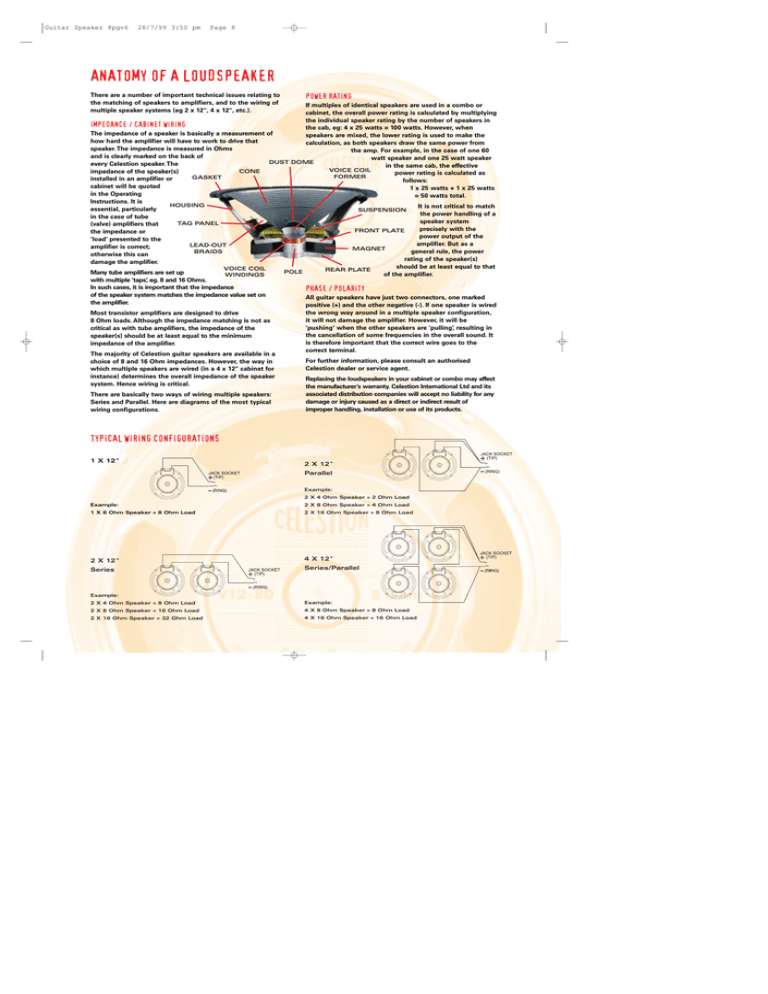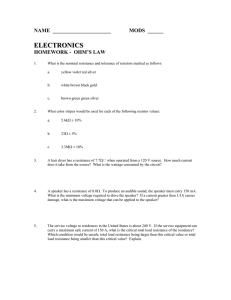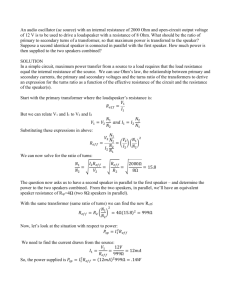Guitar Speaker 8pgv6
advertisement

Guitar Speaker 8pgv6 28/7/99 3:50 pm Page 8 ANATOMY OF A LOUDSPEAKER There are a number of important technical issues relating to the matching of speakers to amplifiers, and to the wiring of multiple speaker systems (eg 2 x 12", 4 x 12", etc.). POWER RATING Most transistor amplifiers are designed to drive 8 Ohm loads. Although the impedance matching is not as critical as with tube amplifiers, the impedance of the speaker(s) should be at least equal to the minimum impedance of the amplifier. the wrong way around in a multiple speaker configuration, it will not damage the amplifier. However, it will be ‘pushing’ when the other speakers are ‘pulling’, resulting in the cancellation of some frequencies in the overall sound. It is therefore important that the correct wire goes to the correct terminal. If multiples of identical speakers are used in a combo or cabinet, the overall power rating is calculated by multiplying the individual speaker rating by the number of speakers in IMPEDANCE / CABINET WIRING the cab, eg: 4 x 25 watts = 100 watts. However, when The impedance of a speaker is basically a measurement of speakers are mixed, the lower rating is used to make the how hard the amplifier will have to work to drive that calculation, as both speakers draw the same power from speaker. The impedance is measured in Ohms the amp. For example, in the case of one 60 and is clearly marked on the back of watt speaker and one 25 watt speaker DUST DOME every Celestion speaker. The in the same cab, the effective VOICE COIL CONE impedance of the speaker(s) power rating is calculated as FORMER GASKET installed in an amplifier or follows: cabinet will be quoted 1 x 25 watts + 1 x 25 watts in the Operating = 50 watts total. Instructions. It is HOUSING It is not critical to match essential, particularly SUSPENSION the power handling of a in the case of tube speaker system TAG PANEL (valve) amplifiers that precisely with the FRONT PLATE the impedance or power output of the ‘load’ presented to the amplifier. But as a LEAD-OUT amplifier is correct; MAGNET BRAIDS general rule, the power otherwise this can rating of the speaker(s) damage the amplifier. should be at least equal to that VOICE COIL REAR PLATE POLE Many tube amplifiers are set up of the amplifier. WINDINGS with multiple ‘taps’, eg. 8 and 16 Ohms. In such cases, it is important that the impedance PHASE / POLARITY of the speaker system matches the impedance value set on All guitar speakers have just two connectors, one marked the amplifier. positive (+) and the other negative (-). If one speaker is wired The majority of Celestion guitar speakers are available in a choice of 8 and 16 Ohm impedances. However, the way in which multiple speakers are wired (in a 4 x 12" cabinet for instance) determines the overall impedance of the speaker system. Hence wiring is critical. There are basically two ways of wiring multiple speakers: Series and Parallel. Here are diagrams of the most typical wiring configurations. For further information, please consult an authorised Celestion dealer or service agent. Replacing the loudspeakers in your cabinet or combo may affect the manufacturer’s warranty. Celestion International Ltd and its associated distribution companies will accept no liability for any damage or injury caused as a direct or indirect result of improper handling, installation or use of its products. TYPICAL WIRING CONFIGURATIONS 1 X 12" 2 X 12" Parallel Example: 2 X 4 Ohm Speaker = 2 Ohm Load Example: 2 X 8 Ohm Speaker = 4 Ohm Load 1 X 8 Ohm Speaker = 8 Ohm Load 2 X 16 Ohm Speaker = 8 Ohm Load 2 X 12" 4 X 12" Series Series/Parallel Example: 2 X 4 Ohm Speaker = 8 Ohm Load Example: 2 X 8 Ohm Speaker = 16 Ohm Load 4 X 8 Ohm Speaker = 8 Ohm Load 2 X 16 Ohm Speaker = 32 Ohm Load 4 X 16 Ohm Speaker = 16 Ohm Load


